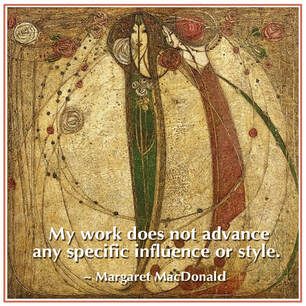|
Joan M. Rehlin
A mini art history post... Born in England, Margaret MacDonald (11/5/1864–1/7/1933) moved with her family to Scotland when she was 26. She and her sister, Frances, enrolled in the Glasgow School of Art and, in the 1890s, opened the MacDonald Sisters Studio in downtown Glasgow. While at the School of Art, MacDonald met Charles Rennie Mackintosh, whom she married on August 22, 1900, and the two of them formed an artistic collaboration that lasted throughout their lives. MacDonald’s well-known works are gesso panels, designed with Mackintosh, which were made for interiors in tearooms and private residences. Although Mackintosh is recognized as Scotland's most famous architect, with his wife being marginalized by comparison, MacDonald was nonetheless celebrated by many of her peers, including her husband. Mackintosh wrote to her, “Remember, you are half if not three-quarters in all my architectural work... .” He further stated that “Margaret has genius. I have only talent.” Between 1895 and 1924, MacDonald contributed to over 40 European and American exhibits including the 1900 Vienna Secession, where she was an influence on Gustav Klimt and other artists. Declining loyalty to any specific movement, she designed pieces which demonstrate an originality that distinguished MacDonald from her contemporaries. In 2008, MacDonald’s White Rose and Red Rose (shown here) was auctioned for 1.7 million UK pounds or $3.3 million. White Rose and Red Rose, gesso on hessian on glass, 1902, Margaret MacDonald
1 Comment
|
ART BLOGWelcome to our Art Blog where we occasionally present topics of interest in the fine art world, including featuring artists other than Jim Rehlin. Some of the artwork has been created by long-departed but well-known greats; some, by compelling contemporary artists. All will be pieces we find worthwhile to share with you. If you like any of these, consider sharing the posts forward to your own blogs and other social media. |
|
Artwork by Jim Rehlin.
Website content and modifications ©2024 Rehlin Graphics / Fine Art. All rights reserved. Click HERE to Visit and Like Rehlin Graphics / Fine Art on Facebook. THANKS! |

 RSS Feed
RSS Feed
